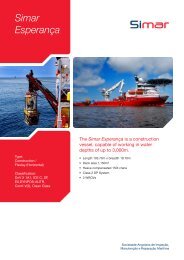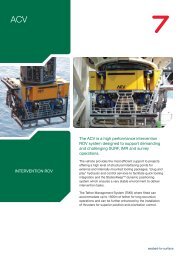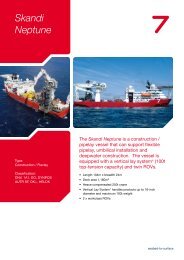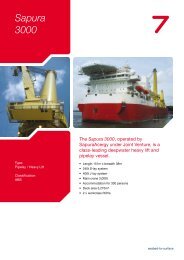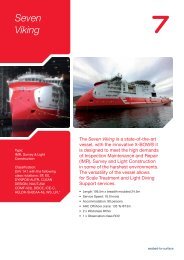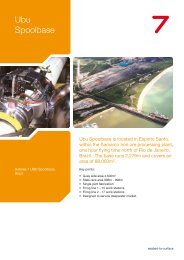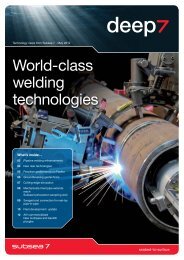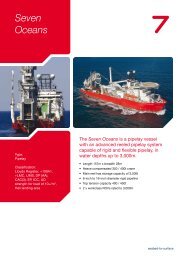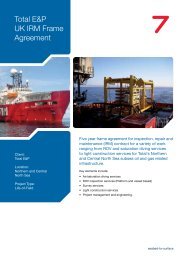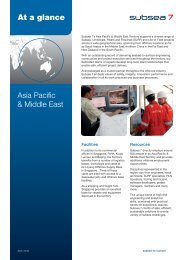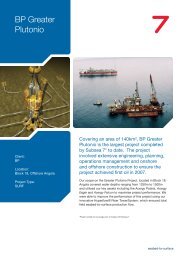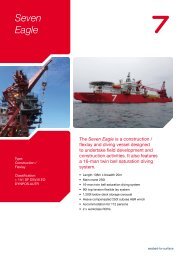Deep 7 - May 2013 - Subsea 7
Deep 7 - May 2013 - Subsea 7
Deep 7 - May 2013 - Subsea 7
Create successful ePaper yourself
Turn your PDF publications into a flip-book with our unique Google optimized e-Paper software.
deep<br />
Technology news from <strong>Subsea</strong> 7 - <strong>May</strong> <strong>2013</strong><br />
What’s inside...<br />
02 High-Performance<br />
Pipe-in-Pipe<br />
Electrically<br />
Trace Heated<br />
Pipe-in-Pipe<br />
under way<br />
see page 3 for more details<br />
04 Riser developments<br />
06 Composite materials<br />
07 High-technology Aasta<br />
Hansteen<br />
08 By-Pass Purge Welding<br />
System<br />
09 Welding qualification for<br />
reelable high-strength steels<br />
10 Next-generation Bundle<br />
technology<br />
11 High-strength Mechanically<br />
Lined Pipe<br />
12 Fleet update<br />
14 Heaviest subsea lift<br />
15 AIV: a game-changing<br />
technology<br />
16 Semi-automatic piggyback<br />
clamping<br />
seabed-to-surface
02<br />
High-Performance<br />
a step-change in thermal<br />
John Mair, Technology Development Director<br />
In-depth technology news<br />
More than ever before, the oil and gas industry<br />
recognises that technological innovation is the<br />
key to exploiting complex new discoveries and<br />
extending the productive life of existing fields.<br />
This has been described as the era of “high<br />
IQ per barrel”, and companies like ours have a<br />
responsibility to innovate, collaborate and open our<br />
doors and minds to enable our clients to achieve<br />
their goals.<br />
For many years, <strong>Subsea</strong> 7 has researched<br />
and investigated subsea industry technology<br />
requirements, and, in this publication, you can read<br />
about the progress of some of the concepts that we<br />
have conceived, commercialised and are applying in<br />
client projects.<br />
We are committed to effective technology<br />
development. We work in successful collaboration<br />
with many clients and development partners, and<br />
we apply our technological expertise through a<br />
number of global internal networks throughout our<br />
company.<br />
We hope that the technologies profiled in these<br />
pages are of benefit to your planned and current<br />
operations. Please don’t hesitate to contact us<br />
if you would like to explore any areas of mutual<br />
technological benefit in more depth.<br />
Over several years,<br />
<strong>Subsea</strong> 7 has<br />
undertaken a continuous<br />
development programme<br />
to bring to the market a<br />
step-change technology<br />
for the thermal insulation<br />
of subsea pipelines.<br />
Annulus with<br />
reduced<br />
pressure<br />
Air gap<br />
<strong>Subsea</strong> 7 has an established<br />
track record of Pipe-in-Pipe (PIP)<br />
design, construction and installation,<br />
with over 40 projects executed to date<br />
by different installation methods, including J-lay, S-lay, towing and,<br />
most recently, reel–lay. To develop the reel–lay solution, we have<br />
collaborated with our development partner ITP InTerPipe to qualify<br />
the most thermally efficient Pipe-in-Pipe technology in the market.<br />
High-Performance PIP – installation by reel-lay<br />
Carrier Pipe<br />
Flowline<br />
Initially a series of full-scale thermal performance tests was<br />
carried out on a purpose-built rig on a wide range of PIP insulation<br />
materials, including measuring the thermal performance before and<br />
after the reeling process.<br />
These tests conclusively demonstrated that the ITP PIP technology<br />
was superior to other insulation products. This was achieved by<br />
using ITP Izoflex insulation material installed within the Pipe-in-<br />
Pipe annulus with a partial vacuum drawdown and the insulation<br />
material acting as a continous centraliser.<br />
This performance, as illustrated in Figure 1, showing the “notouch”<br />
cool-down time approximately three times better than other<br />
products.<br />
Dr Stuart N Smith, Vice President Technology<br />
& Asset Development<br />
John Mair, Technology Development Director<br />
Fig 1.<br />
100<br />
95<br />
90<br />
Post Bending Cooldown Test Results Comparison<br />
85<br />
Fig 2.<br />
80<br />
50<br />
40<br />
Izoflex<br />
Aerogel<br />
Insulation Thickness vs U‐Value for 10" PiP Flowline<br />
Temperatures (°C)<br />
75<br />
70<br />
65<br />
60<br />
55<br />
Reduced Pressure<br />
10" x 16" PIP<br />
50<br />
45<br />
40<br />
Insulation Thickness (mm)<br />
30<br />
20<br />
Izoflex without<br />
centralisers<br />
10" x 15" PIP<br />
35<br />
30<br />
25<br />
0 5 10 15 20 25 30 35 40 45 50 55 60 65 70 75 80 85 90 95 100 105 110 115 120 125<br />
Time (Hours)<br />
10" x 14" PIP<br />
10<br />
0<br />
0.3 0.5 0.7 0.9 1.1 1.3 1.5 1.7 1.9<br />
Another benefit is illustrated in Figure 2 (opposite), is that with the<br />
High-Performance PIP product, a smaller annulus is required for a<br />
given U-value. This has the potential for a smaller outer pipe to be<br />
used, resulting in considerable cost savings.<br />
U‐Value (W/m 2 K)<br />
DEEP7 <strong>May</strong> <strong>2013</strong>
Pipe-in-Pipe:<br />
performance<br />
03<br />
Electrically Trace Heated PIP<br />
– installation by reel-lay<br />
Building upon this design, the next phase in the development<br />
programme was the qualification and commercialisation of an<br />
Electrically Trace Heated option.<br />
Electrically Trace Heated PIP technology combines our High-<br />
Performance PIP technology with a low-power electrical<br />
heating arrangement to deliver further significantly enhanced<br />
flow assurance properties. The electrical heating comprises<br />
individual three-phase wiring triplets configured in a star<br />
arrangement.<br />
Heating Wire Arrangement<br />
<strong>Subsea</strong> 7’s reel-lay vessel Seven Oceans laying pipe<br />
The interest in High-Performance and Electrically Trace Heated<br />
PIP technology is growing, with many operators, including<br />
majors and independents, evaluating the potential benefits for<br />
their projects.<br />
The space available within the annulus enables a number<br />
of circuits to be installed, thereby providing a high level of<br />
redundancy.<br />
The high level of thermal efficiency of our design provides<br />
the further benefit of a low power requirement to meet the<br />
specified pipeline heat-up time. This enables a low-voltage<br />
system to be adopted with the advantage of longer stepout<br />
distance and use of field-proven electrical connectors.<br />
In normal operation, the system provides “no-touch” times<br />
of 72 hours or more before the heating system needs to be<br />
activated to maintain the flowline above Wax Appearance<br />
Temperature (WAT) or Hydrate Appearance Temperature (HAT),<br />
with a typical power consumption of 5-10W/m.<br />
The high-specification insulated heating wires, as part of the<br />
qualification, have been subjected to accelerated ageing tests<br />
and are located in contact with the outside diameter of the<br />
inner pipe and held in place by the insulation material.<br />
Finite Element analysis has been performed to evaluate the<br />
impact on the wires during the reeling process. This has also<br />
been validated by simulated reeling trials to demonstrate that<br />
no detrimental impact is experienced.<br />
This development work has been performed in full compliance<br />
with DNV Recommended Practice for new technology DNV RP<br />
A203, and has culminated in the award of Fitness for Service<br />
qualification.<br />
This accreditation provides a high level of confidence to clients<br />
who are looking to address flow assurance issues of long<br />
shutdown and start-up conditions (e.g. hydrate formation)<br />
and enable longer, more cost-effective single-line tie-back<br />
distances.<br />
The nature of the reel-lay installation method is particularly<br />
suited to Electrically Trace Heated PIP, since the wires can be<br />
installed in long stalks onshore, unlike with J-lay or S-lay.<br />
<strong>Subsea</strong> 7 has completed an in-depth qualification for Total and<br />
is currently working closely with Noble Energy for a deepwater<br />
subsea field that would be dependent on Electrically Trace<br />
Heated PIP technology for the field development.<br />
An integrated project team has been set up in Houston to<br />
complete the detailed engineering and discrete qualification of<br />
project-specific elements of the Trace Heating system.<br />
Pipeline fabrication will be performed in one of <strong>Subsea</strong> 7’s<br />
spoolbases, with installation planned by our flagship reel-lay<br />
vessel, Seven Oceans.<br />
Looking to the future, further enhancements of both High-<br />
Performance and Electrically Trace Heated PIP may include<br />
the incorporation of fibre optic monitoring to track temperature<br />
throughout the length of the pipeline.<br />
Outer Pipe<br />
Steel wrapping<br />
Insulation<br />
Fibre optic temperature<br />
monitoring<br />
Heating wires<br />
Production Pipe<br />
For further information contact John.Mair@subsea7.com<br />
seabed-to-surface
04<br />
Recent riser developments<br />
Dr Stuart N Smith, Vice President Technology & Asset Development<br />
Over many years, <strong>Subsea</strong> 7 has developed a unique suite<br />
of riser concepts and related technologies to meet a wide<br />
range of specific field characteristics, such as water depth,<br />
environmental conditions, host specification, hydrocarbon<br />
composition and client preferences.<br />
The continuous development of our riser technology is of<br />
great strategic importance in enabling our clients to meet the<br />
demands associated with ever-increasing challenges of water<br />
depth, corrosion, fatigue and harsh environments.<br />
Looking to the future, the growing demand for increased<br />
corrosion resistance, high-pressure capacity requirements and<br />
fatigue life is driving the need for new materials. High-strength<br />
steels and composite materials such as carbon fibre are now<br />
being considered as realistic future technological alternatives<br />
to conventional carbon steel. We are actively engaged in<br />
developing and qualifying a number of these novel initiatives<br />
(see page 6).<br />
The following overview provides an update of <strong>Subsea</strong> 7 riser<br />
developments associated with challenging offshore projects<br />
around the world.<br />
Hybrid Riser Tower (HRT)<br />
The Hybrid Riser Tower concept is a complex<br />
and effective riser system pioneered by <strong>Subsea</strong> 7<br />
over 15 years ago to gather all carried fluids for a<br />
deepwater or ultra-deepwater field into a vertical<br />
bundle for transfer to an FPSO.<br />
<strong>Subsea</strong> 7 is currently constructing two HRTs in<br />
Angola for Total’s CLOV project in 1,300m water<br />
depth in Block 17. As part of our continuous<br />
development programme, we are focussed on four<br />
main areas:<br />
• Investigation of the hydrodynamic behaviour<br />
which is sensitive to Galloping, VIV and VIM,<br />
through Basin test campaigns and CFD<br />
computations.<br />
Hybrid Riser Tower<br />
Steel Catenary Risers (SCRs)<br />
• Investigation of the use of non-metallic materials to save<br />
weight and reduce the amount of buoyancy required.<br />
Steel Catenary Risers (SCRs) are a preferred riser system for<br />
many field developments due to their cost efficiency, ease of<br />
installation and track record. Installation can typically be by<br />
all three methods available from <strong>Subsea</strong> 7: J-lay, S-lay and<br />
reel-lay.<br />
<strong>Subsea</strong> 7 installed the first-ever metallurgically clad SCR<br />
in Shell’s Bonga development offshore Nigeria by the J-lay<br />
method, followed by Exxon Mobil’s Erha development,<br />
also offshore Nigeria. Installation by reel-lay has also been<br />
performed in Brazil and the Gulf of Mexico.<br />
• Review of our design methodology to increase its<br />
sensitivity and efficiency by the extensive use of global<br />
modelling approaches and fatigue calculations.<br />
• Enhancement of our safety and maintenance<br />
performance by developing a top tower diverless<br />
connection system for flexible jumpers.<br />
The programme deliverables have already produced<br />
benefits on projects such as Total’s CLOV project in Angola,<br />
where the use of polymer materials has been adopted for<br />
the HTR Guiding Frames.<br />
The Steel Lazy Wave Riser (SLWR), an innovative derivative<br />
of the SCR, was also successfully installed on Shell’s BC-10<br />
project off Brazil in 1,800m water depth.<br />
A common requirement of most SCRs is the need for the<br />
highest quality welding and inspection technology, particularly<br />
in the case of installation by reel-lay.<br />
Qualification of the required welding technology for reel-lay<br />
was successfully performed by <strong>Subsea</strong> 7 to confirm:<br />
DEEP7 <strong>May</strong> <strong>2013</strong>
05<br />
Buoyancy Supported Riser (BSR)<br />
The scale of <strong>Subsea</strong> 7’s innovative Buoyancy<br />
Supported Riser system is clearly seen here<br />
during the arrival in Brazil of the first of the<br />
large buoys on which the decoupled riser<br />
system is based.<br />
The buoys for the Petrobras Guará-Lula NE<br />
project in the Santos Basin arrived in the port<br />
of São Sebastião from Qingdao Wuchuan<br />
Heavy Industry’s shipyard in China where<br />
they were fabricated. Each buoy measures<br />
around 50m by 40m and weighs over 2,500t<br />
for the first installation phase of the project,<br />
the largest Engineering, Procurement,<br />
Installation and Commissioning (EPIC) SURF<br />
contract to be awarded to date in Brazil.<br />
The system is designed to accommodate a<br />
large numbers of risers in a small area in a<br />
decoupled arrangement. In this case, there<br />
are twenty-seven 3.9km steel catenary risers,<br />
of which eighteen are 7.5-inch production<br />
lines, three 9.5-inch water injection lines and<br />
six 8-inch gas injection lines.<br />
The SCRs will be fabricated at <strong>Subsea</strong> 7’s<br />
spoolbase in Brazil, installed and hooked<br />
up by reel-lay to the four subsurface buoys,<br />
each of which is tethered by tendons<br />
adjusted with a purpose-designed jacking<br />
system. The buoys are submerged<br />
approximately 250 metres below the surface<br />
and are connected to the FPSO by flexible<br />
jumpers.<br />
First two Guará-Lula NE buoys arrive at Sao Sebastiao port, Brazil<br />
The BSR system is designed to absorb the dynamics from<br />
the FPSO, resulting in reduced dynamic stresses on the<br />
SCRs.<br />
With the pre-salt Guará-Lula NE fields lying in depths<br />
beyond 2,100m, the production and water injection lines<br />
are constructed predominantly from BUTTING BuBi ®<br />
Mechanically Lined Pipe, and this will be the first time<br />
Mechanically Lined Pipe is installed by the reel-lay method<br />
anywhere in the world.<br />
The use of Mechanically Lined Pipe resulted in a significant<br />
cost and schedule saving, while still being qualified for a<br />
dynamic SCR in sour service conditions.<br />
Jumper vertical connectors<br />
• Mechanical and corrosion testing of girth welds met<br />
industry standards<br />
• Girth welds are suitable for reeling<br />
• Automated Ultrasonic Testing (AUT) verification<br />
• Girth welds meet or exceed DNV class C/2 fatigue<br />
performance.<br />
Shell developed the SLWR concept to improve fatigue<br />
performance and to reduce payload on the FPSO turret in<br />
ultra-deep water. Buoyancy elements were attached to the<br />
risers in the sag bend region near the TDP along with a 23m<br />
long flex-joint assembly to achieve an SLWR configuration<br />
that provided better compliance of the riser to FPSO motion<br />
responses in harsh environmental conditions, thereby<br />
improving fatigue life.<br />
In a recent study, <strong>Subsea</strong> 7’s SLWR experience and Weight<br />
Distributed Steel Catenary Riser (WDSCR) technology have<br />
been combined to demonstrate that the long low-wave<br />
configuration can provide a robust solution for future presalt<br />
projects in Brazil.<br />
Shell BC10 Lazy Wave Riser configuration<br />
For further information contact Stuart.Smith@subsea7.com<br />
seabed-to-surface
06<br />
Emerging materials for<br />
riser solutions<br />
John Mair, Technology Development Director<br />
The oil and gas industry has widely adopted<br />
the use of composites in a variety of<br />
applications over the past 20 years, including<br />
onshore production piping, fire water<br />
pipe and repair. The increasing demands<br />
on materials to meet future technical<br />
requirements for risers, flowlines, spools<br />
and components such as stress joints is<br />
leading the industry to take a closer look<br />
at composites for these more demanding<br />
applications.<br />
Technical specifications to address the<br />
requirements associated with pressure,<br />
temperature, corrosion and fatigue are<br />
stretching the suitability of established metallic<br />
and non–bonded flexible options. Bonded<br />
composite thermoplastic pipe is a high-end<br />
composite solution that directly addresses many<br />
of these challenges while delivering substantial<br />
reductions in vessel payload.<br />
<strong>Subsea</strong> 7 has undertaken a number of studies<br />
with two of the principal market-leading<br />
companies in bonded composite technology,<br />
Airborne and Magma, to evaluate the<br />
possibilities for this emerging technology, and<br />
understand the opportunities and challenges in<br />
its design and installation.<br />
A phased approach is also being adopted<br />
towards the introduction and potential<br />
applications of this technology by a number<br />
of operators in order to gain a detailed<br />
understanding for its deployment in such<br />
demanding emerging applications as deepwater<br />
risers. High sour environments and hightemperature<br />
applications that could potentially<br />
see a significant reduction in top-tension<br />
buoyancy requirements are also issues under<br />
consideration.<br />
The riser designs of both Airborne and Magma<br />
use bonded composite thermoplastic-based<br />
technology.<br />
One area of consistent interest in this technology<br />
is for deepwater spools. Spool fatigue is one<br />
example where fluctuating flow regimes and<br />
riser movement may be better accommodated<br />
by the properties of composite products in<br />
terms of flexibility and fatigue resistance.<br />
A composite spool can more readily<br />
accommodate dynamic loads, flex to absorb<br />
movement in the riser and flowline and offer<br />
opportunities to streamline the deployment<br />
and connection approach. <strong>Subsea</strong> 7 is<br />
currently leading studies to assess these<br />
potential benefits.<br />
Similarly, at the upper end of the riser, the<br />
connection arrangement experiences many<br />
of the same challenges. With its superior<br />
flexibility and fatigue resistance, bonded<br />
composite thermoplastic pipe could<br />
be suitable as a taper joint alternative<br />
to the conventional flex joint in these<br />
increasingly demanding applications.<br />
<strong>Subsea</strong> 7 has engaged with Magma<br />
to qualify its carbon fibre PEEK<br />
product, m-pipe ® , for a taper joint<br />
design specifically for Catenary<br />
Riser-type configurations. Magma’s<br />
choice of premium materials, laser<br />
manufacturing process and endfitting<br />
approach align m-pipe ® with<br />
some of the most demanding design<br />
challenges we will face.<br />
m-pipe ®<br />
Airborne<br />
Conventional Flex Joint<br />
For further information contact John.Mair@subsea7.com<br />
DEEP7 <strong>May</strong> <strong>2013</strong>
07<br />
<strong>Deep</strong>water technologies<br />
in the Norwegian Sea<br />
Stian Sande, <strong>Subsea</strong> 7’s Aasta Hansteen Project Manager<br />
In early <strong>2013</strong>, <strong>Subsea</strong> 7 was<br />
awarded a contract by Statoil for the<br />
construction of the Aasta Hansteen<br />
gas field in the northern Norwegian<br />
Sea, north of the Arctic Circle, in<br />
water depths of 1,300m.<br />
As well as being the deepest<br />
development in the Norwegian Sea,<br />
and involving the installation of the<br />
world’s largest SPAR gas platform,<br />
Aasta Hansteen is a technology-driven<br />
development that includes two notable<br />
“firsts” for <strong>Subsea</strong> 7 in the harsh<br />
environment of the Norwegian Sea:<br />
deployment of Steel Catenary Risers<br />
(SCRs) and reel-lay of Mechanically<br />
Lined Pipe (BuBi ® ) flowlines tying-back<br />
three subsea production templates to<br />
the SPAR.<br />
<strong>Subsea</strong> 7’s scope of work comprises<br />
engineering, procurement, installation<br />
and commissioning (EPIC) responsibility<br />
for the infield flowlines and steel<br />
catenary risers, and involves the<br />
procurement of Mechanically Lined<br />
(BuBi ® ) linepipe for the flowlines, the<br />
coating of linepipe for the flowlines<br />
and SCRs, as well as fabrication of all<br />
pipeline for reel-lay installation.<br />
The infield pipeline system consists<br />
of four 12-inch outer diameter (OD)<br />
thermally insulated BuBi ® pipe flowlines<br />
with a total length of 18km. One<br />
flowline runs between subsea locations<br />
while the other three run from subsea<br />
locations to the SPAR platform and<br />
are tied-in via 12-inch OD thermally<br />
insulated metallurgically clad pipe SCRs<br />
of approximately 2,000m length each.<br />
The pipeline system also includes<br />
coating, fabrication and installation of<br />
one 14-inch OD corrosion protection<br />
coated carbon steel pipe SCR,<br />
approximately 2,000m long, for gas<br />
export.<br />
All the SCRs, including fatigue zones,<br />
will be installed by the reel-lay method<br />
as part of the flowline installation<br />
campaign with Seven Oceans in<br />
2015, and laid down temporarily for<br />
subsequent pull-in and hang-off after<br />
tow-out and mooring of the SPAR<br />
platform in 2016.<br />
The 12-inch<br />
OD SCRs are<br />
connected to<br />
the flowlines by<br />
tapered transitions<br />
and welded<br />
connections.<br />
SCRs in deepwater<br />
development<br />
can be subject<br />
to severe<br />
environmental<br />
loading, and<br />
the fatigue<br />
performance is<br />
often limited by<br />
the girth weld.<br />
Installation of<br />
SCRs by the reel-lay method has been<br />
demonstrated to be cost-effective. A<br />
significant benefit for SCR fabrication is<br />
that the majority of the girth welds can<br />
be fabricated and inspected onshore<br />
in a controlled environment, making it<br />
easier to ensure that the required high<br />
weld integrity is achieved.<br />
The prerequisites for fabrication of SCR<br />
welds include:<br />
• Close control of pipe-end tolerances<br />
and joint misalignment.<br />
• High-integrity welding procedures.<br />
• Flush grind of the weld caps<br />
to achieve the highest fatigue<br />
performance.<br />
<strong>Subsea</strong> 7 has developed and<br />
qualified welding and inspection<br />
procedures which meet these exacting<br />
requirements, and can demonstrate a<br />
significant track record in successful<br />
production deployment for the<br />
fabrication of carbon steel and clad/<br />
lined SCRs for reel-lay installation.<br />
<strong>Subsea</strong> 7 also has EPIC responsibility<br />
for the rigid spools, monitoring system<br />
and strakes for the SCRs, protection<br />
structures and suction anchors for<br />
anchoring the risers and flowlines, as<br />
well as for the SPAR itself.<br />
Further work includes the transportation<br />
and installation of control umbilicals,<br />
umbilical riser base, manifold structures,<br />
connections and pre-commissioning<br />
activities.<br />
The contract also includes the<br />
transportation and installation of the<br />
mooring system for the SPAR buoy,<br />
tow-out of the SPAR, including hook-up<br />
of the mooring system and pull-in of the<br />
SCRs and dynamic umbilical.<br />
The Aasta Hansteen field will be the<br />
most northerly development in the<br />
Norwegian Sea and will serve as a hub<br />
for future field developments in the area.<br />
<strong>Subsea</strong> 7 will deploy various highend<br />
pipelay, construction, flex-lay and<br />
survey vessels during the offshore<br />
period in 2015 and 2016, including<br />
Seven Oceans for the rigid pipelay,<br />
Seven Pacific for the umbilical<br />
installation and Skandi Acergy for the<br />
installation of large structures. Pipeline<br />
production of the SCRs and pipelines<br />
will take place at <strong>Subsea</strong> 7’s spoolbase<br />
at Vigra, Norway.<br />
The Aasta Hansteen award confirms<br />
<strong>Subsea</strong> 7’s status as a contractor<br />
capable of delivering pioneering<br />
technology, and in particular transferring<br />
deepwater development experience<br />
gained in Brazil, West Africa and<br />
West of Shetland to emerging, harshenvironment<br />
regions like the Norwegian<br />
Sea.<br />
To support this milestone project,<br />
<strong>Subsea</strong> 7 will also open a new office in<br />
Northern Norway.<br />
For further information contact<br />
Stian.Sande@subsea7.com<br />
seabed-to-surface
08<br />
First deployment of unique<br />
By-Pass Purge welding system<br />
Richard Jones, Welding Technology Manager<br />
The Skuld project offshore pipelay<br />
operation for Statoil offshore Norway<br />
using Seven Oceans presented the first<br />
opportunity to implement the<br />
<strong>Subsea</strong> 7 Aquasol By-Pass Purge<br />
system for execution of the offshore<br />
tie-in welds. Performance of these<br />
critical welds is made difficult by the<br />
‘suck and blow’ conditions within the<br />
pipeline which cause difficulties in<br />
creating an inert purge atmosphere<br />
needed to ensure the soundness of the<br />
girth weld.<br />
The unique design feature of the By-Pass<br />
Purge includes a fully sealed enclosure<br />
to maintain the integrity of the purge gas<br />
together with a central vent which allows<br />
the draughts to pass through the pipeline<br />
without disturbing the internal purge gas.<br />
The entire system is made uniquely of fully<br />
water-soluble materials, which enables the<br />
system to be flushed out on completion,<br />
and its design and materials are sufficiently<br />
robust to withstand the rigours of offshore<br />
operations. This innovative system<br />
significantly increases the reliability of<br />
offshore welding operations with better<br />
assurance of weld quality and minimal risk<br />
of extended vessel time.<br />
By-pass purge enclosure in place<br />
Welding advances in<br />
fabrication of metallurgically<br />
clad pipe<br />
Last year saw the successful production<br />
deployment of <strong>Subsea</strong> 7’s Pulsed Gas<br />
Metal Arc Welding (PGMAW) latest<br />
welding technology for the fabrication<br />
of metallurgically clad pipe in our reeled<br />
pipeline production facility in Vigra,<br />
Norway.<br />
A key part of the welding solution is the<br />
use of the Controlled Metal Transfer<br />
(CMT) process for root welding. This<br />
is an advanced Gas Metal Arc Welding<br />
(GMAW) technique which allows the weld<br />
root to be deposited very precisely, giving<br />
good control of the root-based quality<br />
and profile. These are essential features<br />
to maintain the corrosion performance<br />
of the pipeline. Assurance of root weld<br />
quality is achieved by internal inspection<br />
using state-of-the-art camera and laser<br />
equipment.<br />
DEEP7 <strong>May</strong> <strong>2013</strong><br />
The Vigra 2012 clad pipeline campaign<br />
involved four projects for Statoil -<br />
Visund Sor, Stjerne, Tordis and Skuld.<br />
The total length of pipeline fabricated<br />
exceeded 60km and pipe dimensions<br />
ranged from 10–16-inches OD with WT<br />
in the range 16–25mm. The linepipe<br />
comprised Grade 415 (X60) with 3mm<br />
316L lining.<br />
During the course of the fabrication,<br />
the laser/camera inspection reject<br />
<strong>Subsea</strong> 7 Aquasol By-Pass Purge arrangement<br />
rate for the final project was less<br />
than 1.4%. Of particular significance<br />
was the Automated Ultrasonic<br />
Testing (AUT) rejection rate on final<br />
inspection procedures which was<br />
kept at a constant low level through<br />
the fabrication campaign at a typical<br />
level 0.2%. The overall successful<br />
completion of the 2012 clad pipe<br />
fabrication campaign is testament to<br />
the reliability of the development CMT/<br />
PGMAW solution.
Global Pipeline<br />
Welding<br />
Development<br />
Centre fully<br />
operational<br />
<strong>2013</strong> saw the completion in Glasgow,<br />
UK, of <strong>Subsea</strong> 7’s new Global Pipeline<br />
Welding Development Centre, managed<br />
by the company’s Pipeline Production<br />
Group (PPG). This new facility<br />
considerably enhances our capacity to<br />
provide leading-edge welding solutions<br />
for the full range of pipeline fabrication<br />
requirements.<br />
09<br />
The new centre incorporates 18<br />
welding bays and supporting cutting<br />
and bevelling facilities to perform<br />
pipeline welding and testing for<br />
spoolbase welding and vessel tie-ins,<br />
as well as simulations for our S-lay and<br />
J-lay vessels.<br />
The existing development centre<br />
has been re-configured to provide<br />
advanced NDT capabilities as well<br />
as dedicated R&D facilities. A major<br />
advantage of the new centre will be its<br />
capability to simulate the production<br />
firing line. This will allow PPG to<br />
perform realistic pre-production<br />
welding trials and operator training,<br />
which will facilitate the efficient transfer<br />
of technology to our fabrication sites<br />
worldwide.<br />
Global Pipeline Welding Development Centre<br />
Welding qualification for reelable high-strength steels<br />
There is increasing demand for<br />
pipeline installation, including SCRs,<br />
in deeper water, coupled with a<br />
requirement for higher operating<br />
pressures and temperatures and<br />
the need to transport corrosive<br />
constituents.<br />
For such applications, the use of<br />
high-strength steel, Grade X80,<br />
offers significant benefits including<br />
a reduction in pipeline weight and<br />
savings in material and fabrication<br />
costs.<br />
Reel-lay offers a cost-effective<br />
offshore installation method for highstrength<br />
steel pipe, although to date<br />
this has been limited to Grade X65/70<br />
strength pipe.<br />
<strong>Subsea</strong> 7, in collaboration with<br />
Vallourec and Mannesman Tubes, has<br />
performed a qualification programme<br />
for reelable X80 linepipe. In this<br />
programme, V&M Tubes manufactured<br />
seamless X80 pipe of 323.9mm OD<br />
x 18mm WT pipe in accordance with<br />
DNV OS-F101, supplementary P<br />
requirements.<br />
<strong>Subsea</strong> 7 developed and qualified<br />
a mechanised girth weld procedure<br />
based on the GMAW-CMT/PGMAW<br />
welding process. Procedure<br />
qualification was successfully<br />
performed in compliance with DNV<br />
OS-F101, including mechanical,<br />
fracture toughness and sour service<br />
testing.<br />
The development of linepipe<br />
material and welding solutions for<br />
reelable high-strength carbon steel<br />
are considered to be key enabling<br />
technologies for the exploitation of<br />
deepwater oil and gas reserves in<br />
the future.<br />
High-strength steel weld detail<br />
For further information contact Richard.Jones@subsea7.com<br />
seabed-to-surface
10<br />
Bundle technology:<br />
the next generation<br />
Sam Watt, Senior Development Engineer<br />
For over 30 years, <strong>Subsea</strong> 7<br />
has been designing, fabricating<br />
and installing Bundles (towed<br />
pipeline production systems)<br />
from our fabrication facilities at<br />
Wick, in the North of Scotland.<br />
With over 70 Bundles installed<br />
to date, this concept is a<br />
well-established and attractive<br />
alternative to individually laid<br />
flowlines in the development of<br />
difficult fields.<br />
The concept<br />
A flowline Bundle consists<br />
of a carrier pipe within which<br />
a combination of individual<br />
flowlines and umbilical<br />
components are housed,<br />
terminating in towhead structures<br />
at each end, which can include<br />
elements required for subsea<br />
production, such as valves and<br />
controls.<br />
By filling the carrier pipe and<br />
towhead tubular sections with nitrogen<br />
and attaching ballast chain at regular<br />
intervals along the Bundle, the<br />
submerged weight is trimmed to enable<br />
the Bundle to be towed at a controlled<br />
depth. This towed production system<br />
also eliminates the requirement for<br />
heavy-lift vessels.<br />
The advantages<br />
Longer tie-back distances, greater fluid<br />
temperatures and pressures, heavier<br />
and more corrosive fluids, deeper water<br />
and harsher environmental conditions<br />
are all technological challenges which<br />
can be met by Bundle technology:<br />
• BUTTING’s BuBi ® CRA-lined pipe<br />
offers significant cost savings<br />
compared to metallurgically clad or<br />
solid CRA linepipe.<br />
• Highly efficient insulation systems<br />
and active hot water-heated or<br />
Electrically Trace Heated Bundles<br />
allow longer tie-back distances and<br />
development of fields with heavier<br />
fluid compositions.<br />
• Bundle systems are considered the<br />
optimum design for HP/HT fields as<br />
DEEP7 <strong>May</strong> <strong>2013</strong><br />
56-inch Bundle carrier pipe<br />
the design permits flowline expansion<br />
along its entire length, reducing<br />
build-up of axial forces and the<br />
susceptibility to upheaval buckling.<br />
At present, the highest design<br />
temperature for a Bundle system is<br />
160°C.<br />
• There is a significantly reduced soils<br />
risk with Bundles with no individual<br />
pipelines to trench and bury, reducing<br />
project CAPEX uncertainty.<br />
• Much of the subsea infrastructure can<br />
be pre-commissioned and tested as<br />
an integrated system while onshore.<br />
• Bundles can usually be installed<br />
nearby or pulled under existing<br />
platforms, drill rigs or other offshore<br />
installations.<br />
• There is generally no requirement for<br />
heavy lift vessels as subsea structures<br />
can be incorporated within the<br />
Bundle system. The heaviest towhead<br />
structure installed to date weighed<br />
approximately 525t, for Total’s Jura<br />
project.<br />
For further information contact<br />
Sam.Watt@subsea7.com<br />
The next generation<br />
• Advances in Bundle design<br />
and analysis can further<br />
advance its suitability to HP/<br />
HT developments. Flowline<br />
pre-tensioning is one potential<br />
enhancement, where the Bundle<br />
fabrication is designed to ‘lock-in’<br />
tension within the inner flowlines,<br />
reducing the propensity to<br />
expand under temperature and<br />
pressure.<br />
• <strong>Deep</strong>er water is a challenge for<br />
Bundle design, since it places<br />
considerable demands on the<br />
collapse resistance of the carrier<br />
pipe and the internal nitrogen<br />
pressures. The greatest water<br />
depth for a Bundle design to<br />
date is 410m, for BG’s Knarr<br />
development, but it is expected<br />
that this can be extended in the<br />
future by the use of alternative<br />
buoyancy arrangements.<br />
• The length limit for a single<br />
Bundle at our Wick facility is<br />
approximately 7,600m; for longer<br />
tie-back distances, multiple<br />
Bundles connected in series are<br />
required. BP’s Andrew project<br />
in the North Sea utilised four<br />
Bundles to span a distance of<br />
27.8km. Options are currently<br />
being considered to increase the<br />
maximum achievable length of a<br />
single Bundle.<br />
• The largest carrier pipe diameter<br />
specified for a project is currently<br />
56-inches, for Total’s West<br />
Franklin development. The<br />
launchway is expected to cope<br />
with carrier pipes up to 60-inches<br />
in size.<br />
• The application of Bundles<br />
in far north fields is currently<br />
being considered, with a study<br />
assessing the feasibility of<br />
installing a Bundle in the Barents<br />
Sea, approximately 2,000km<br />
from Wick, where soil conditions<br />
are extremely challenging due to<br />
historic iceberg scarring.<br />
• Health monitoring systems are<br />
becoming available which allow<br />
corrosion, erosion, blockages and<br />
leaks to be monitored in real-time.<br />
Incorporating these systems into<br />
Bundles will enhance <strong>Subsea</strong> 7’s<br />
Life-of-Field capabilities.<br />
We believe that <strong>Subsea</strong> 7’s Bundle<br />
technology will continue to play a<br />
key role, both in the North Sea and<br />
progressively further afield.
11<br />
Development of high-strength<br />
Mechanically Lined Pipe<br />
by reel-lay<br />
Grégory Toguyeni, Senior Welding & Materials Engineer<br />
The successful collaboration<br />
between <strong>Subsea</strong> 7 and manufacturer<br />
BUTTING has already led to the<br />
world’s first qualification of the<br />
use of Mechanically Lined Pipe for<br />
reel-lay installation of flowlines and<br />
risers globally, as a cost-effective<br />
alternative to solid corrosionresistant<br />
alloys or metallurgically clad<br />
pipe.<br />
Further broadening of the technology<br />
has been undertaken in order to expand<br />
the application of Mechanically Lined<br />
Pipe to larger pipeline diameters, higher<br />
fatigue requirements and material<br />
grades.<br />
As part of the qualification programme,<br />
comprehensive fatigue testing<br />
performed on previously reeled X65<br />
pipe mechanically lined with Inconel<br />
625 has demonstrated high fatigue<br />
performance up to DNV class C, thus<br />
allowing more flexibility in SCR design<br />
criteria and the use of this product to<br />
even greater water depth.<br />
<strong>Subsea</strong> 7, Vallourec and Mannesman<br />
Tubes and BUTTING have collaborated<br />
to bring to the market an X80 grade<br />
BuBi ® Mechanically Lined Pipe.<br />
Recent development work has<br />
demonstrated the viability of highstrength<br />
Mechanically Lined Pipe<br />
for installation by reel-lay, allowing a<br />
reduction of the pipeline weight and<br />
its application to high-pressure, hightemperature<br />
conditions. Additional<br />
advantages of the use of high-strength<br />
grades for the carbon steel outer<br />
pipe are a reduction in buoyancy<br />
module requirements and the possible<br />
pipeline installation by existing pipelay<br />
vessels which would otherwise require<br />
increased top-tension capability for<br />
deepwater installation, if lower strength<br />
pipe was used.<br />
The top-tension reduction will also be<br />
of significant benefit to the project host<br />
facility.<br />
The high-strength development<br />
programme had a number of key<br />
objectives:<br />
• To demonstrate the pipe mill and<br />
BUTTING can manufacture highstrength<br />
lined pipe to the same reeling<br />
specifications as for lower grades.<br />
• To develop a welding procedure<br />
satisfying the quality and mechanical<br />
property requirements associated with<br />
reel-lay installation.<br />
• To demonstrate that the global<br />
plastic deformation associated with<br />
reeling was not detrimental to the<br />
acceptability of the installed lined<br />
pipe.<br />
Results to date have successfully<br />
demonstrated that:<br />
• V&M can manufacture the X80 grade<br />
carbon steel to the appropriate<br />
specification in terms of DNV SMLS<br />
555 suitable for reeling.<br />
• The BuBi ® liner assembly at BUTTING<br />
and the pipe-end seal weld/weld<br />
overlay arrangement met the required<br />
quality.<br />
• <strong>Subsea</strong> 7 can apply the required girth<br />
welding technology to construct the<br />
pipeline and meet all the demands of<br />
the reeling process.<br />
One of the key technical challenges is<br />
the requirement to have the strength of<br />
the girth weld exceed that of the carbon<br />
steel pipeline material.<br />
Internal welding<br />
Conventionally for X65 carbon steel<br />
Alloy 625 can be used as the welding<br />
consumable and the overmatching<br />
strength achieved. In the case of X80<br />
grade, Alloy 625 weld strength is lower<br />
therefore this option is not available.<br />
<strong>Subsea</strong> 7 has therefore developed<br />
an innovative welding solution which<br />
was qualified in compliance with DNV<br />
welding requirements. This solution is<br />
based on an internally welded alloy 625<br />
root weld and an external carbon steel<br />
weld.<br />
This combination has demonstrated that<br />
the corrosion resistance, high-strength<br />
and toughness requirements can be<br />
met.<br />
The reliability of this test programme<br />
has demonstrated the successful<br />
combination of BUTTING’s BuBi ® pipe<br />
technology and <strong>Subsea</strong> 7’s pipeline<br />
design, fabrication and installation<br />
capabilities.<br />
This market recognition contributed<br />
to the award of the Guará-Lula NE<br />
project by Petrobras in Brazil, where it<br />
is intended to deploy 70km of 8-inch<br />
BuBi ® pipe by <strong>Subsea</strong> 7’s Seven<br />
Oceans reel-lay vessel, and by Statoil<br />
for the Aasta Hansteen project, which<br />
includes the design, coating, fabrication<br />
and installation of 19km of 12-inch<br />
BuBi ® lined pipe flowlines.<br />
Full-scale reeling trial<br />
<strong>Subsea</strong> 7 has recently successfully<br />
performed a full-scale reeling trial on<br />
the Seven Oceans reel-lay vessel at the<br />
Vigra spoolbase in Norway, where all<br />
aspects of the BuBi ® pipe installation<br />
and emergency abandonment<br />
procedures were demonstrated.<br />
Internally welded root weld detail<br />
For further information contact Grégory.Toguyeni@subsea7.com<br />
seabed-to-surface
12<br />
Fleet development update<br />
<strong>Subsea</strong> 7’s fleet of over 40 vessels includes a<br />
number of industry-leading, high-performance<br />
vessels which have been specifically designed to<br />
meet client requirements for vessels capable of<br />
executing ever-larger, more complex projects at<br />
greater depths and in harsher environments.<br />
We have invested over $3 billion in our fleet<br />
development programme during the last five<br />
years, including Seven Borealis, the largest capital<br />
investment project ever undertaken by <strong>Subsea</strong> 7 at<br />
approximately $550 million.<br />
Seven Borealis was delivered on schedule during<br />
2012 to Total’s CLOV Project, offshore Angola,<br />
where the vessel is already utilising <strong>Subsea</strong> 7’s latest<br />
mechanised welding technologies on its J-lay firing<br />
line.<br />
Other recent additions to the fleet emphasise our<br />
commitment to giving our clients access to marketleading<br />
vessels with the highest standards of versatility<br />
and project reliability: Seven Viking, custom-built<br />
for all-year-round IMR operations in harsh marine<br />
environments, and Seven Waves, a high-performing<br />
flexible PLSV for the Brazilian market.<br />
Seven Borealis<br />
Seven Borealis is <strong>Subsea</strong> 7’s flagship pipelay/heavy-lift vessel,<br />
with a number of innovative, custom-designed components<br />
for its 600t tension S-lay system (up to 46-inch pipe diameter<br />
utilising three tensioners) and 937t top tension J-lay system<br />
(up to 24-inch pipe diameter).<br />
The tensioners, stinger and stinger support frame were all<br />
specifically designed for the vessel, and the S-lay system<br />
offers great flexibility in how the firing line is configured and<br />
the types of pipelines the vessel is capable of handling, as well<br />
as feeding the J-lay system.<br />
Seven Borealis also features anti-heel and anti-roll systems<br />
designed to ensure a stable working environment even during<br />
delicate pipelay operations in challenging sea states and while<br />
working with heavy loads.<br />
On a vessel with a 5,000t mast crane, the offset loads can<br />
be significant, so Seven Borealis features five pairs of ballast<br />
tanks which can accommodate water transfers at up to 13m 3<br />
per minute to keep the vessel balanced.<br />
A “passive” roll-damping system is also incorporated to<br />
reduce the roll motion induced by heavy sea states. This is<br />
based on four large flume tanks filled to ensure the water level<br />
is in anti-phase to the ship’s roll, and creating a damping effect<br />
on the motion.<br />
In optimum conditions, the tanks can reduce the roll by around<br />
40% and greatly enhance the operability of the vessel.<br />
The 5,000t mast crane, with the top of its mast reaching 150m<br />
above the main deck, is the world’s largest offshore mast<br />
crane, and gave an early demonstration of its capabilities in<br />
the installation of the 1,630t J-lay tower.<br />
An equally impressive installation lift was the 385t lift of a<br />
stinger section at a radius of 104m.<br />
DEEP7 <strong>May</strong> <strong>2013</strong><br />
Seven Borealis also features a 600t A&R winch utilising<br />
135mm diameter wire for 3,000m water depths, a 1,200t<br />
heave-compensated auxiliary hoist and incorporates 2,400t<br />
onboard pipe storage.<br />
This flagship vessel is one of <strong>Subsea</strong> 7’s highly versatile global<br />
enablers, capable of meeting exacting heavy lift and pipelay<br />
requirements in the deepest and most harsh environments.<br />
For further information contact Ben.Moffat@subsea7.com
13<br />
Seven Viking<br />
In early <strong>2013</strong>, the new-build Seven Viking entered<br />
a long-term contract with Statoil for Inspection,<br />
Maintenance and Repair and light construction<br />
operations in the North, Norwegian and Barents<br />
Seas. The robust, specialised vessel is designed<br />
for operation in harsh environments, and features<br />
ICE-C classification and a compact design that<br />
reduces motion in transit, gives increased stability<br />
and enhances manoeuvrability.<br />
Despite its compact size, the vessel draws on<br />
<strong>Subsea</strong> 7’s extensive IMR experience to include an<br />
innovative configuration that maximises hull space<br />
and offers extended equipment and tool-handling<br />
capacity within a large heated indoor hangar area.<br />
Among the many novel features designed to<br />
facilitate IMR operations in rough seas and extreme<br />
temperatures is a customised module-handling<br />
system (MHS) integrated in the hangar which<br />
enables the controlled launch and recovery of<br />
subsea modules up to 10m in height and weighing<br />
up to 70t through the moonpool in water depths up<br />
to 2,000m.<br />
The MHS has two AHC lifting winches, one 70t and<br />
2,000m and the other 20t and 1,000m. The system<br />
also incorporates an automatic prong/cursor<br />
system, operates up to 5m significant wave height<br />
and has possibilities for combined lifting.<br />
To minimise working at heights and manual handling, man-riding lifts and utility cranes are<br />
also installed in the hangar area, and noise levels are minimised by the use of all-electric<br />
winches for the ROVs, the MHS and utility equipment.<br />
The vessel’s continuous skidding system has storage capacity for up to eight pallets,<br />
including four indoor storage positions. Twist locks are integrated into part of the 840sq.m<br />
working deck for quicker mobilisation and demobilisation of standard containers.<br />
Seven Viking is another versatile, class-leading vessel to be added to the <strong>Subsea</strong> 7 fleet,<br />
and has immediately gone into all-year-round service in the challenging Norwegian waters<br />
for which she has been designed.<br />
For further information contact Bjoernserck.Hanssen@subsea7.com<br />
Seven Waves<br />
Fabrication of the new-build flexible PLSV Seven Waves<br />
is now complete, with approximately 6,000t of steel on<br />
the berth in Holland prior to her launch in <strong>May</strong> <strong>2013</strong>. By<br />
April <strong>2013</strong>, 140km out of 300km of electrical cable had<br />
been pulled, and almost 11,000 of her 13,000 pipe spools<br />
installed.<br />
The vessel is scheduled for delivery to Petrobras in 2014<br />
on a long-term charter contract following her launch in <strong>May</strong><br />
<strong>2013</strong> in Holland. Her sea-trials will take place in September<br />
<strong>2013</strong>, following which her 550t Tiltable Lay System (TLS)<br />
will be installed, also in Holland.<br />
The vessel’s high-specification top-tension capability<br />
gives Seven Waves one of the highest-performing flexible<br />
pipelay capabilities in the world, reflecting the existing and<br />
anticipated requirements of Brazilian deepwater and ultradeepwater<br />
operations.<br />
The TLS incorporates two 275t retractable tensioners to<br />
handle flexible products between 100mm and 630mm outer<br />
diameter. The tower can tilt to 10 o when operational to<br />
recover rigid pipe from the seabed but it can also tilt to 50 o<br />
from the vertical to allow the TLS to clear overhead cables at<br />
the entrance to Vitoria harbour in Brazil.<br />
For further information contact<br />
Brian.Rice@subsea7.com<br />
seabed-to-surface
14<br />
Heaviest and deepest<br />
subsea lifts<br />
Marin Abélanet, Engineering Director,<br />
Asia, Australia and New Zealand<br />
<strong>Subsea</strong> 7 has been awarded a contract<br />
by Chevron Australia for the Heavy<br />
Lifts and Tie-ins scope for the Gorgon<br />
Project, which is developing the<br />
Gorgon and Jansz-Io gas fields off the<br />
northwest coast of Western Australia.<br />
The contract will see <strong>Subsea</strong> 7 deploying<br />
some of the largest and heaviest subsea<br />
structures in the industry to date.<br />
At the Jansz-Io field, there are a total of<br />
six structures with a total weight in air of<br />
circa 3,500 tonnes which will be lowered<br />
to the seabed at an average depth of<br />
1,300m.<br />
In order to deploy these large structures<br />
safely and efficiently to the deepwater<br />
section of the Jansz–Io field, <strong>Subsea</strong> 7<br />
is investing in a customised deepwater<br />
lowering system, which will be selfcontained<br />
and mobilised as a single unit<br />
on board the heavy lift vessel<br />
Sapura 3000.<br />
This lowering system comprises two<br />
identical capstan traction winches of<br />
180t capacity, reeved in four falls with<br />
6,000m of wire. It has a maximum<br />
dynamic capacity of 1,300 tonnes at<br />
1,300m and will be delivered later in<br />
<strong>2013</strong>.<br />
The large structures will be offloaded<br />
from the transport barges using the<br />
vessel’s 2,600t capacity main crane and<br />
transferred via a lowering beam to the<br />
<strong>Deep</strong>water Lowering System. They will<br />
then be deployed directly in one single<br />
operation to the seabed.<br />
This latest addition to <strong>Subsea</strong> 7’s<br />
range of heavy lift subsea equipment<br />
<strong>Deep</strong>water lowering system<br />
will open new opportunities for the<br />
deployment of larger, heavier elements<br />
of subsea infrastructure in future<br />
deepwater developments.<br />
* The Gorgon Project is operated by an<br />
Australian subsidiary of Chevron and is a<br />
joint venture of the Australian subsidiaries<br />
of Chevron (47.3 percent), ExxonMobil (25<br />
percent), Shell (25 percent), Osaka Gas (1.25<br />
percent), Tokyo Gas (1 percent) and Chubu<br />
Electric Power (0.417 percent).<br />
For further information contact<br />
Marin.Abelanet@subsea7.com<br />
Improving vessel utilisation<br />
<strong>Subsea</strong> 7 is currently working on a number of new severeweather<br />
technology initiatives to enhance operations in<br />
challenging sea states. One is a crane lifting aid under<br />
development by <strong>Subsea</strong> 7 designed to improve deckhandling<br />
safety during lifting and with the potential to<br />
significantly extend winter-weather operations in harsh<br />
waters like the Norwegian Sea.<br />
The Universal Launch Assistant (ULA) is a load-controlling<br />
mechanical arrangement attached to the crane pedestal of<br />
existing vessels and controlled by the crane operator. Its<br />
telescopic arms swivel around the crane pedestal, and give<br />
firmer and safer handling of horizontal inertia loads including<br />
templates, manifolds and associated spools even in sea<br />
states above the current limiting range of 1.5-2m significant<br />
wave height.<br />
The ULA replaces the use of winches with holdback wires<br />
which are conventionally used to control horizontal loads, and<br />
therefore enhances on-board safety as well as significantly<br />
improving the utilisation of vessels involved in construction<br />
work in challenging weather conditions.<br />
A traction ring and slider arrangement allows the main structure and the<br />
telescopic arms to swivel through 360° around the crane pedestal. The<br />
Master and Auxiliary telescopic arms extend and retract in order to reach the<br />
equipment on the deck and facilitate load damping, enhancing the operational<br />
efficiency of vessels involved in construction work.<br />
For further information contact<br />
Sigbjorn.Daasvatn@subsea7.com<br />
DEEP7 <strong>May</strong> <strong>2013</strong>
Autonomous intelligent<br />
inspections: a game-changing<br />
technology<br />
15<br />
Scott Cormack, Sales and Marketing Director,<br />
Life-of-Field and i-Tech - Global<br />
After five years of intensive prototype<br />
development, <strong>Subsea</strong> 7’s pioneering<br />
Autonomous Inspection Vehicle<br />
(AIV) has recently undergone its final<br />
phase of verification trials in the<br />
challenging waters off Peterhead and<br />
Fort William, in Scotland.<br />
Having now qualified its full system<br />
robustness, we will bring the Mark 1 AIV<br />
to market for commercial deployment<br />
later in <strong>2013</strong>.<br />
The AIV has been developed in<br />
collaboration with SeeByte, a leading<br />
developer of underwater robotic<br />
software, and the vehicle will change<br />
the way infield inspections, light<br />
intervention and environmental activities<br />
are delivered.<br />
The vehicle’s unique station-keeping<br />
and hovering ability represents the next<br />
step in the evolution of autonomous<br />
systems in the marine environment.<br />
Operating directly and tether-free<br />
from an offshore host facility (FPSO,<br />
platform or support vessel), the first<br />
commercial AIV will be capable of<br />
regular inspections of risers, pipelines<br />
and seabed equipment.<br />
A more rapid field assessment can<br />
be made using multiple systems<br />
operating together from a single support<br />
vessel. This capability has never been<br />
commercially available until now, and<br />
represents a truly game-changing<br />
technology for Life-of-Field operations.<br />
Multi-vehicle “install and retrieve later”<br />
campaigns of this type can utilise a lowcost<br />
support vessel to optimise mission<br />
coverage, sending data onshore for<br />
processing, and carry out simultaneous<br />
field survey and inspection activities.<br />
In order to balance performance with<br />
energy consumption, the vehicle hull<br />
shape was analysed and optimised<br />
using advanced Computational Fluid<br />
Dynamics (CFD). The Mark 1 AIV has a<br />
customised launch and recovery system<br />
with an A-frame<br />
deployment basket.<br />
Last year saw the<br />
final simulation phase<br />
of development, with<br />
hundreds of virtual AIV<br />
missions performed within<br />
a 3D offshore oilfield representation to<br />
ensure that the remote decision-making<br />
of the autonomous vehicle was robust.<br />
Since then, the software system has<br />
been further hardened to optimise the<br />
vehicle’s dynamic ability to recognise<br />
subsea infrastructure environments,<br />
make optimum decisions and complete<br />
pre-planned missions.<br />
The Mark 1 AIV can be utilised on<br />
single- or multi-vehicle campaigns or<br />
smaller packages of work, or deployed<br />
long-term on a platform or FPSO for<br />
ad-hoc or regular field inspections with<br />
no need for support vessel mobilisation.<br />
This latter scenario can benefit integrity<br />
management performance by the<br />
early identification of issues requiring<br />
remedial action.<br />
AIV deployment system<br />
In the longer-term, operators may also<br />
utilise the AIV’s intelligent decisionmaking<br />
capabilities in a number<br />
of ways: to complement the preprogrammed<br />
activities of Autonomous<br />
Underwater Vehicles (AUVs), to build<br />
AIV compatible interfaces into subsea<br />
infrastructure design, to perform posthurricane<br />
inspections or, looking further<br />
ahead, for deployment in future underice<br />
subsea developments.<br />
System specifications<br />
Depth rating 3,000m<br />
Dimensions 1700mm (L) x 800mm (H)<br />
x 1300mm (W)<br />
Weight in air 790kg<br />
Endurance<br />
Maximum<br />
excursion<br />
Positioning<br />
accuracy<br />
Inspection<br />
sensors<br />
Comms<br />
24 hours, dependent on<br />
conditions<br />
40,000m, dependent on<br />
conditions (ie currents)<br />
within 1.5-3m inspection<br />
range following seabed<br />
infrastructure<br />
3D forward-looking<br />
sonar<br />
Colour inspection class<br />
video camera<br />
Profiling sonar and<br />
downward look camera<br />
Acoustic in-water, Wi-Fi<br />
on deck, satellite for<br />
emergency location<br />
Navigation Dead reckoning (1%<br />
distance travelled) aided<br />
by sensor data and<br />
seabed markers<br />
For further information contact Scott.Cormack@subsea7.com<br />
seabed-to-surface
Gateway to the Arctic<br />
<strong>Subsea</strong> 7 has established its Arctic research competency in<br />
St. John’s, Newfoundland and Labrador, whose icy offshore<br />
environment is classified as sub-Arctic.<br />
Although not as challenging as the Arctic, the basins off the<br />
coast of Newfoundland, where current oil and gas resources are<br />
being exploited, have harsh metocean and ice conditions that<br />
are continuously changing. From intense winter storms to sea<br />
ice and icebergs in the spring, and heavy fog in the summer,<br />
this unique combination of environmental conditions has made<br />
the development of offshore energy resources very challenging.<br />
St. John’s, often referred to as the “Gateway to the Arctic”,<br />
is already the focal point for offshore resource development<br />
in Canada, leading to the widespread establishment of Arctic<br />
research facilities in the area.<br />
The sub-Arctic technology<br />
solutions developed in<br />
St. John’s are likely to<br />
be transferable to more<br />
difficult Arctic regions as<br />
offshore development<br />
moves further north,<br />
and <strong>Subsea</strong> 7 is already<br />
working in collaboration with operator clients, local Arctic<br />
experts and dedicated research facilities toward identifying<br />
targeted Arctic challenges and developing research and<br />
technology development programmes to meet them.<br />
For further information contact Dwayne.Hopkins@subsea7.com<br />
Simultaneous dual pipeline<br />
installation<br />
An innovative process which allows for the<br />
simultaneous pipelay of a flexible pipe or cable<br />
attached onto a more robust carrier pipe has<br />
been developed by <strong>Subsea</strong> 7 and successfully<br />
deployed for the first time in the harsh waters<br />
West of Shetland, where weather dependency<br />
is a major limiting factor to efficient pipelay<br />
operations.<br />
The conventional process for such an operation<br />
is “piggybacking”, a labour-intensive process<br />
involving manual blocks and banding procedures,<br />
which typically restrict pipe-laying speed.<br />
In 2011, <strong>Subsea</strong> 7 first started work on developing<br />
a more efficient and safer solution – a semiautomatic<br />
process where operators did not<br />
have to work in close proximity to the moving<br />
pipelines, and where accelerated lay-rates would<br />
be possible.<br />
This new system made its operational debut on<br />
Total’s 142km Laggan-Tormore pipeline in 2012,<br />
on which Seven Oceans applied over 30,000 of<br />
the new clamps without impacting on the pipelay<br />
rate.<br />
It is recognised that conventional banding<br />
has significant limitations for fast, automatic<br />
piggybacking, so, after detailed study of the<br />
installation and operational conditions, the<br />
developers decided to trial a semi-automatic<br />
machine which would simultaneously align the<br />
two pipes together and apply a new quick-locking<br />
block concept.<br />
After intensive testing of the prototype clamps, a suitable material for the<br />
blocks was identified – a tough, inert, water-resistant plastic. A design<br />
was developed by which the two halves of the block could be quickly<br />
locked around the pipes by six quick-fastening, barbed stainless steel<br />
fixings.<br />
The new system has a number of advantages – it is quick to apply, and<br />
can cater for a wide range of pipe diameters.<br />
The robustness of the design is also advantageous when pipelines are<br />
pulled through a long conduit, as was the case with Laggan-Tormore.<br />
This procedure can damage conventional banding, but no piggyback<br />
clamps were lost during the system’s inaugural deployment.<br />
For further information contact Lee.Rolf@subsea7.com<br />
www.subsea7.com<br />
DEEP7 <strong>May</strong> <strong>2013</strong><br />
© <strong>Subsea</strong> 7, <strong>2013</strong>. Information correct at time of going to press.



